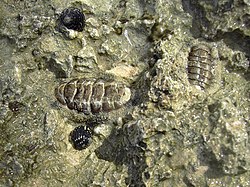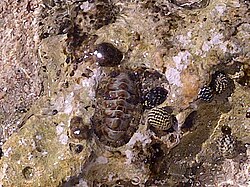| Acanthopleura granulata | |
|---|---|
 | |
| Live individual on a rock in Guadeloupe | |
| Scientific classification | |
| Kingdom: | Animalia |
| Phylum: | Mollusca |
| Class: | Polyplacophora |
| Order: | Chitonida |
| Family: | Chitonidae |
| Genus: | Acanthopleura |
| Species: | A. granulata |
| Binomial name | |
| Acanthopleura granulata (Gmelin, 1791) | |
| Synonyms | |
Chiton granulatus Gmelin, 1791, Chiton blauneriShuttleworth, 1856 Contents | |
Acanthopleura granulata, common name the West Indian fuzzy chiton (also known as Curbs or Sea Cradles), [1] is a medium-sized tropical species of chiton. This type of chiton's activity does not depend on spring-neap oscillations leading to lower locomotion loss. [2] Its morphology is different from usual chitons as it has a fifth valve, which is split into halves. [3]
This species is common within its range in the tropical Western Atlantic, but it is often not noticed, because its color and texture are similar to the rocks on which it lives. With not many predators the West Indian fuzzy chiton can live up to 40 years. [1]
In countries that used to be part of the British West Indies, these and other common intertidal chitons are known as "curb"; the foot of the animal is eaten by people and is also used as bait for fishing.





